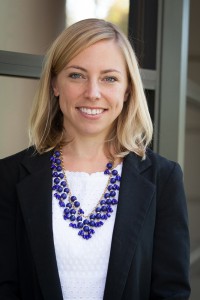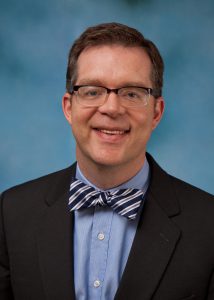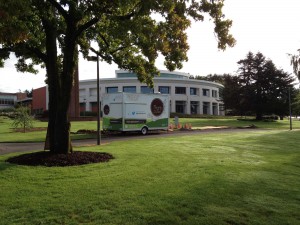
English instructor Alexis Nelson
English instructor Alexis Nelson has taught at Clark College for four years. Last year she became active in the committee that organizes the college’s Columbia Writers Series (CWS), which brings accomplished writers to the college to read from and discuss their work; the next installment of the series is on Monday, Nov. 18. Nelson, who earned her Bachelor of Arts degree in English Literature from the University of California at Santa Barbara, has a Master of Fine Arts degree in Nonfiction Writing from Portland State University. Recently, Clark 24/7 chatted with her about CWS, as well as about a new English course she’s helping to develop and her own recent brush with literary fame.
I understand you’ve become part of the group that organizes Clark’s Columbia Writers Series. Could you tell me a little bit about that event and its purpose?
The Columbia Writers Series brings professional authors to campus to read from and talk about their work. We bring in local and national fiction writers, nonfiction writers, poets, playwrights and screenwriters. As for the purpose of the series, last year I had a student tell me she didn’t “get” poetry until she attended a CWS reading, with the poet Matthew Dickman. Hearing Dickman read his work helped this student appreciate and understand poetry in a new way, and it got her interested in attending more readings in the future. To me, that’s what CWS is all about: enriching the educational experience of Clark students by introducing them to contemporary authors and by exposing them to literature in a new way. The series also emphasizes Clark’s role as a center for arts and culture within the community, and it builds connections between Clark faculty, students, and members of the public.
CWS seems to be undergoing a sea change recently. What’s the thought process behind that, and what can we look forward to seeing at CWS in the future?
There is a core group of English department faculty that is really excited about CWS right now, and we’ve been putting a lot of work into getting great authors to come to campus and creating more awareness of our readings. We’re all writers ourselves, and we see so much opportunity to build this series into something truly special for Clark and the community. We’ve also been working on building stronger connections between CWS and some of the other exciting creative writing initiatives we have at Clark. For instance, last year, Clark’s art and literary journal, Phoenix, published a fantastic interview with one of our CWS readers, Charles D’Ambrosio. D’Ambrosio is an award-winning author with a national reputation, and having that in-depth interview with him was great for Phoenix, not to mention a wonderful opportunity for the student who conducted the interview. We’d love to be able to do more things like this in the future, in addition to continuing to bring in the best writers from the Northwest and beyond.
Tell me about this coming CWS reading.
I’m really excited about the November 18 reading for a couple of reasons. First, we’re going to have two writers: poet Zachary Schomburg and fiction-writer Ismet Prcic. Zachary and Ismet both won Oregon Book Awards this year, so this is a chance to hear two of the Northwest’s best contemporary writers share their work. I’m also especially excited for this reading because Ismet actually teaches at Clark—he’s an adjunct in the Drama department—so we’ll also be celebrating Clark’s talented faculty. Ismet was born in Bosnia and his award-winning novel Shards tells the story of a young Bosnian immigrant, so there’s also a connection between the November 18 reading and International Education Week, which will be happening at the same time.
I know you’ve been developing a Creative Nonfiction course at Clark. How did that come about, and what role do you think the course will fill at Clark?
Creative nonfiction is an important genre that has become a lot more prominent and popular in the last couple of decades. It’s a diverse genre that includes things like memoir, personal essay, travel writing, and even journalistic pieces that use some of the techniques of fiction-writing such as description and scene-building. If you look at other schools that offer fiction and poetry writing courses, most of them will have creative nonfiction writing classes as well. My MFA is in nonfiction writing, and I’m a nonfiction writer myself, so when I saw that there weren’t any creative nonfiction courses being offered at Clark, I wanted to design one. I think this class will help round out the creative writing offerings at Clark. It’s also an important course because this type of writing is fun and creative, but it also has practical applications. If you’re interested in writing for magazines, you need to know creative nonfiction. Being able to write a great personal essay will also help with college and scholarship applications.
How do Clark students respond to the coursework in this class?
When I taught nonfiction writing at Clark last spring, I had a number of Running Start students who were in their teens; there were also several returning students in their 30s and 40s. To me, this diversity is part of what makes Clark special. Particularly in a class where you’re writing from personal experience, having students who have been through a lot in their lives and others who are just beginning to figure out who they are makes for a dynamic class. The students were so respectful of one another, and I think that both the older and the younger students learned a lot from each another.
How has teaching this course informed your own writing process?
Teaching forces me to think about how different pieces of writing are put together, and to put into words ideas about craft that I might not otherwise fully articulate to myself. I also like to do all the writing exercises that I give my students along with them, and this can sometimes open unexpected doors for me and lead to new work. Overall, it’s just great to be immersed in reading, thinking, and talking about the kind of writing I’m most passionate about. It’s like breathing richer air.
Finally, I know you’re hesitant to talk about this, but your essay, “On Love and Memory,” was recently listed as a notable essay in The Best American Essays 2013. How does it feel to have your work recognized by such a prestigious publication? Also, since the original essay isn’t available online, could you share a little about its theme?
One of my grandmothers had dementia and the other currently has Alzheimer’s; so the essay is partly about what they’ve gone through and partly about my own fears of losing my memory. It also, like the title suggests, explores the relationship between memory and love. The essay is structured like a collage, with short, discrete sections that are woven together to create a whole that’s greater than the sum of its parts. It’s a somewhat experimental kind of writing that I’ve been really excited by lately.
I was thrilled when the essay was published in the first place (in a great journal called The Normal School), but knowing that it stood out to the editor of the Best American Essays series feels even better. At the same time, it’s funny how quickly the initial excitement over getting news like that fades, in the sense that it doesn’t make the work any easier. I’d imagine that even getting a big book deal or winning a prestigious prize would be same. Afterward, you still have to go back to your desk and figure out how to put more words on the page.
Photo: Clark College/Jenny Shadley


